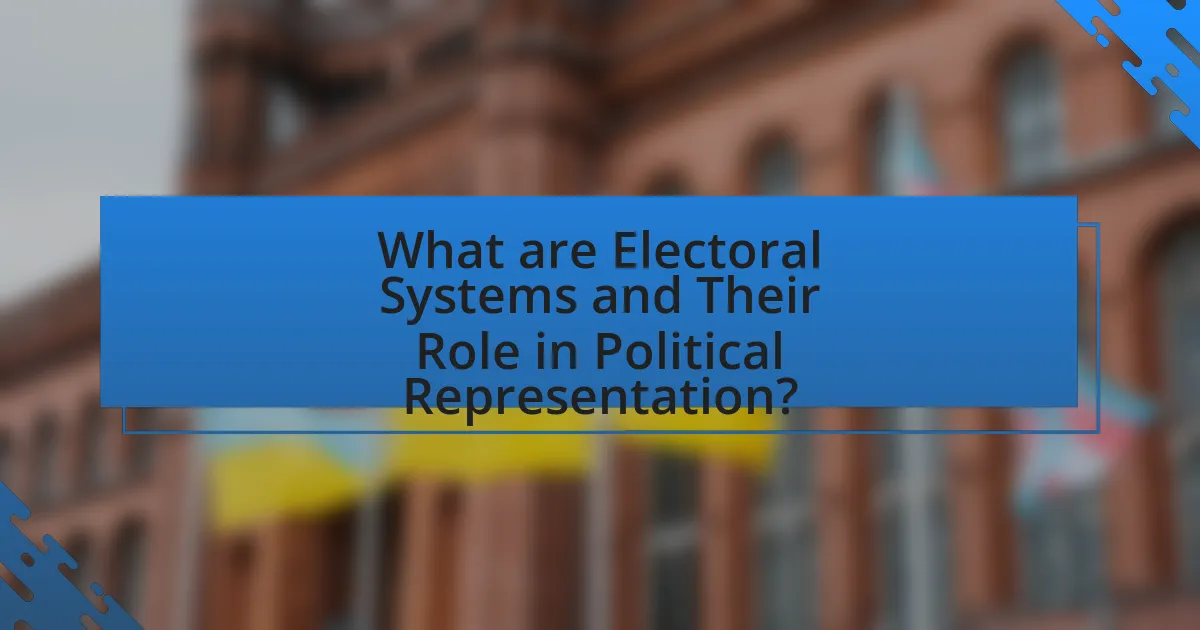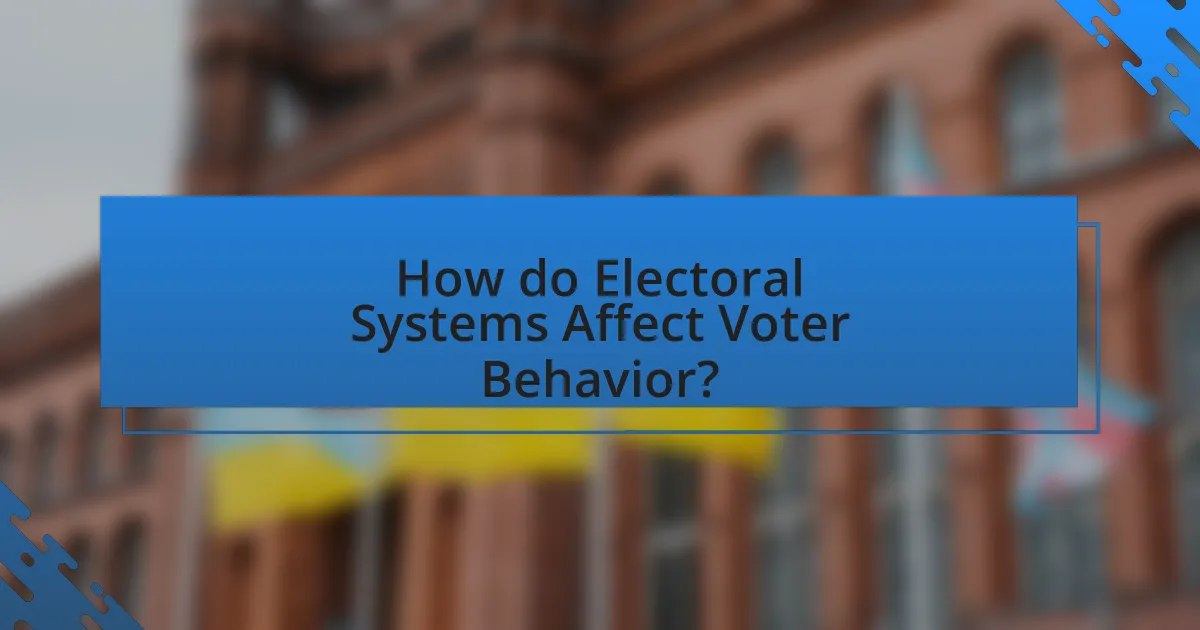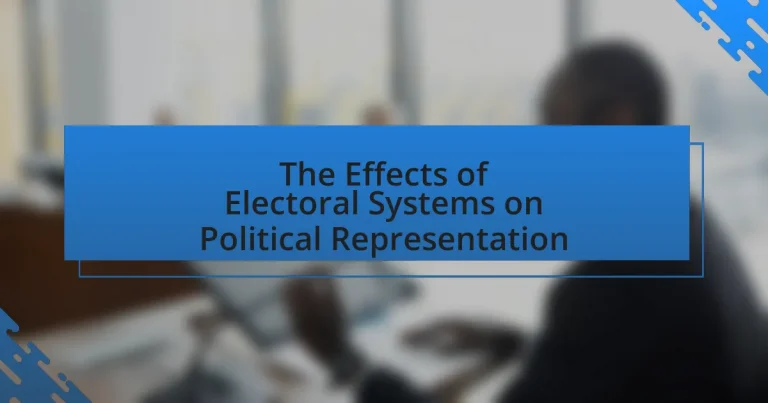Electoral systems are critical frameworks that determine how votes are translated into political representation, significantly influencing the effectiveness of governance and the reflection of voter preferences in legislative bodies. This article explores various electoral systems, including plurality, majority, and proportional representation, and their impact on political representation, voter behavior, and party dynamics. It examines how these systems affect voter turnout, minority representation, and the overall political landscape, highlighting the importance of electoral design in fostering accountability, inclusiveness, and effective governance. Additionally, the article discusses challenges such as gerrymandering and the implications of electoral systems on public policy and political outcomes.

What are Electoral Systems and Their Role in Political Representation?
Electoral systems are the methods used to conduct elections and translate votes into political representation. These systems play a crucial role in determining how effectively the electorate’s preferences are reflected in legislative bodies. For instance, proportional representation systems tend to yield a legislature that mirrors the overall vote distribution more accurately than winner-takes-all systems, which can lead to significant disparities between the percentage of votes received by a party and the percentage of seats they obtain. Historical evidence shows that countries employing proportional representation, such as Sweden and the Netherlands, often have higher voter satisfaction and engagement, as these systems allow for a broader spectrum of political views to be represented.
How do different electoral systems function?
Different electoral systems function by determining how votes are translated into seats in a legislature. For instance, in a first-past-the-post system, the candidate with the most votes in a constituency wins, often leading to a winner-takes-all outcome. In contrast, proportional representation systems allocate seats based on the percentage of votes each party receives, promoting a more equitable representation of diverse political views.
For example, in the 2019 Israeli elections, a proportional representation system allowed smaller parties to gain representation in the Knesset, reflecting a broader spectrum of voter preferences. This contrasts with the U.S. House of Representatives, where the first-past-the-post system often results in a two-party dominance, limiting the representation of smaller parties. Thus, the design of electoral systems significantly influences political representation and party dynamics within a given political landscape.
What are the main types of electoral systems?
The main types of electoral systems are plurality, majority, proportional representation, and mixed systems. Plurality systems, such as first-past-the-post, allow candidates to win by receiving the most votes, even if they do not achieve an absolute majority. Majority systems, like the two-round system, require candidates to secure more than 50% of the votes, often leading to a runoff if no candidate meets this threshold. Proportional representation systems allocate seats based on the percentage of votes each party receives, promoting a more accurate reflection of voter preferences in legislative bodies. Mixed systems combine elements of both plurality or majority and proportional representation, aiming to balance direct representation with proportionality. These classifications are essential for understanding how different electoral systems influence political representation and voter engagement.
How does each electoral system impact voter choice?
Electoral systems significantly impact voter choice by influencing how votes translate into seats and the overall political landscape. For instance, in a first-past-the-post system, voters often feel compelled to vote strategically for candidates with a higher chance of winning, which can limit genuine expression of preference. This system tends to favor larger parties, leading to a two-party dominance, as evidenced by the United States, where the Democratic and Republican parties dominate elections, often marginalizing smaller parties.
In contrast, proportional representation systems allow for a more accurate reflection of voter preferences in the legislature. Countries like Sweden utilize this system, enabling smaller parties to gain representation, which encourages voters to support candidates aligned with their views rather than those perceived as viable winners. This can lead to a more diverse political discourse and greater voter engagement, as seen in the higher voter turnout rates in countries with proportional representation compared to those with first-past-the-post systems.
Additionally, mixed electoral systems combine elements of both, impacting voter choice by allowing for both direct representation and proportionality. Germany’s mixed-member proportional system exemplifies this, where voters cast two votes: one for a candidate and another for a party, leading to a more nuanced representation of voter preferences. This system can enhance voter satisfaction and participation, as it mitigates the feeling of wasted votes.
Overall, the design of an electoral system shapes voter behavior, party dynamics, and the overall political environment, influencing how effectively voter preferences are represented in governance.
Why is political representation important in a democracy?
Political representation is crucial in a democracy because it ensures that the diverse interests and voices of the population are reflected in government decision-making. This representation allows citizens to have a say in the policies that affect their lives, fostering accountability and responsiveness from elected officials. Studies, such as those conducted by the International Institute for Democracy and Electoral Assistance, show that effective political representation leads to increased public trust in government and higher levels of civic engagement, as citizens feel their opinions are valued and considered in the political process.
What are the key principles of political representation?
The key principles of political representation include accountability, responsiveness, and inclusiveness. Accountability ensures that representatives are answerable to their constituents, fostering trust and transparency in governance. Responsiveness requires that elected officials address the needs and preferences of the electorate, adapting policies to reflect public opinion. Inclusiveness emphasizes the importance of representing diverse groups within society, ensuring that marginalized voices are heard and considered in the political process. These principles are foundational for effective democratic governance, as they promote a system where citizens feel engaged and represented.
How does representation affect public policy and governance?
Representation significantly influences public policy and governance by ensuring that diverse interests and perspectives are reflected in decision-making processes. When electoral systems promote proportional representation, they enable a wider array of voices, including marginalized groups, to participate in governance. This inclusivity leads to policies that address the needs of a broader segment of the population, as evidenced by countries like Sweden and New Zealand, where proportional representation has resulted in more comprehensive social policies. Conversely, systems that favor majoritarian representation often lead to the dominance of a few voices, potentially neglecting minority interests and resulting in policies that do not reflect the electorate’s diversity. Thus, the structure of representation directly shapes the effectiveness and equity of public policy outcomes.
What challenges do electoral systems pose to political representation?
Electoral systems pose significant challenges to political representation by influencing the degree to which diverse viewpoints are reflected in governance. For instance, winner-takes-all systems, such as first-past-the-post, often lead to disproportionate representation, where a party can secure a majority of seats without a corresponding majority of votes, marginalizing smaller parties and minority interests. This phenomenon is evidenced by the 2019 UK general election, where the Conservative Party won 365 seats with only 43.6% of the popular vote, illustrating how electoral design can distort representation. Additionally, proportional representation systems, while more inclusive, can lead to fragmented parliaments and unstable coalitions, complicating governance and decision-making processes. Thus, the structure of electoral systems directly impacts the effectiveness and inclusivity of political representation.
How do electoral systems influence minority representation?
Electoral systems significantly influence minority representation by determining how votes are translated into seats in legislative bodies. Proportional representation systems, for example, tend to enhance minority representation by allowing smaller parties, which often represent minority interests, to gain seats in proportion to their share of the vote. In contrast, winner-takes-all systems, such as first-past-the-post, often marginalize minority groups by favoring larger parties, leading to underrepresentation. Evidence from various countries shows that nations employing proportional representation, like Sweden and the Netherlands, have higher rates of minority representation compared to those using majoritarian systems, such as the United States and the United Kingdom, where minorities often struggle to secure legislative seats.
What are the implications of gerrymandering on representation?
Gerrymandering significantly distorts political representation by manipulating district boundaries to favor one party over another. This practice leads to unequal representation, as it can create “safe” districts where one party dominates, reducing competition and voter choice. For instance, a study by the Brennan Center for Justice found that in states with extreme gerrymandering, the winning party can secure a disproportionate number of seats relative to their overall vote share, undermining the principle of fair representation. Consequently, gerrymandering can disenfranchise voters, diminish accountability, and exacerbate political polarization.

How do Electoral Systems Affect Voter Behavior?
Electoral systems significantly influence voter behavior by shaping how individuals perceive their votes and the overall electoral process. For instance, in proportional representation systems, voters are more likely to feel that their votes count, as these systems tend to translate votes into seats more equitably, leading to higher voter turnout. Research by Blais and Massicotte (2002) indicates that countries with proportional representation often experience turnout rates exceeding 80%, compared to first-past-the-post systems, where turnout can be as low as 50%. This disparity arises because voters in winner-takes-all systems may feel their votes are less impactful, discouraging participation. Additionally, electoral systems can affect party loyalty and strategic voting; in majoritarian systems, voters may choose to support a less preferred but more viable candidate to avoid “wasting” their vote. Thus, the design of electoral systems plays a crucial role in shaping voter engagement and decision-making processes.
What factors influence voter turnout in different electoral systems?
Voter turnout is influenced by several factors inherent to different electoral systems, including the type of electoral system, voter registration processes, and the competitiveness of elections. For instance, proportional representation systems tend to encourage higher voter turnout compared to majoritarian systems, as they provide voters with a greater sense of efficacy and representation. Research indicates that countries with proportional representation, such as Sweden and Denmark, often see turnout rates exceeding 80%, while majoritarian systems, like the United States, typically experience turnout rates around 60% in presidential elections. Additionally, the ease of voter registration significantly impacts turnout; systems that allow same-day registration or automatic registration tend to have higher participation rates. Furthermore, the perceived competitiveness of elections can motivate voters to participate; when elections are closely contested, turnout often increases, as seen in the 2020 U.S. presidential election, which had one of the highest turnout rates in recent history at approximately 66.7%.
How does the design of an electoral system motivate voter participation?
The design of an electoral system motivates voter participation by influencing the perceived efficacy of individual votes and the overall competitiveness of elections. Systems that utilize proportional representation tend to encourage higher voter turnout, as they provide a greater chance for diverse political views to be represented, making voters feel that their participation has a tangible impact. For instance, countries like Sweden and Denmark, which employ proportional representation, consistently report voter turnout rates exceeding 80%, compared to the United States, where the first-past-the-post system results in lower participation rates, often around 60%. This correlation suggests that when voters believe their votes contribute to the outcome, they are more likely to engage in the electoral process.
What role does electoral competitiveness play in voter engagement?
Electoral competitiveness significantly enhances voter engagement by creating a sense of urgency and importance around elections. When elections are closely contested, voters perceive their participation as crucial to the outcome, which motivates higher turnout rates. Research indicates that competitive elections can lead to a 10-20% increase in voter turnout compared to non-competitive ones, as seen in various studies analyzing turnout data across different electoral systems. This heightened engagement is driven by the belief that each vote carries more weight in a competitive context, thereby fostering a more active and involved electorate.
How do electoral systems shape party systems and political competition?
Electoral systems significantly shape party systems and political competition by determining how votes translate into seats in legislative bodies. For instance, proportional representation systems tend to encourage multi-party systems, as they allow smaller parties to gain representation, leading to a more diverse political landscape. In contrast, majoritarian systems, such as first-past-the-post, often result in a two-party system, as they favor larger parties and can marginalize smaller ones. This dynamic influences political competition by affecting the strategies parties adopt; in multi-party systems, coalition-building becomes essential, while in two-party systems, parties may focus on broad appeal to capture the majority. Historical examples include the United Kingdom’s first-past-the-post system, which has led to a dominant two-party system, compared to Sweden’s proportional representation, which has fostered a multi-party environment with numerous parties represented in parliament.
What is the relationship between electoral systems and party fragmentation?
Electoral systems significantly influence party fragmentation, with proportional representation systems typically leading to higher levels of fragmentation compared to majoritarian systems. In proportional representation systems, such as those used in many European countries, multiple parties can gain representation in the legislature, which encourages the formation of smaller parties and coalitions. For instance, in the 2019 European Parliament elections, countries like Belgium and Sweden exhibited a high number of parties represented, reflecting the fragmentation associated with their proportional systems. Conversely, majoritarian systems, like that of the United States, tend to favor a two-party system, resulting in lower levels of fragmentation as smaller parties struggle to gain traction. This relationship is supported by empirical studies, such as those conducted by Lijphart, which demonstrate that electoral systems shape the number and strength of political parties within a given political landscape.
How do electoral systems affect the emergence of new political parties?
Electoral systems significantly influence the emergence of new political parties by determining the conditions under which these parties can gain representation. Proportional representation systems, for instance, facilitate the entry of new parties by allowing them to gain seats in the legislature even with a small percentage of the vote, as seen in countries like Sweden and the Netherlands, where multiple parties thrive. In contrast, winner-takes-all systems, such as those in the United States and the United Kingdom, tend to favor established parties, making it difficult for new parties to gain traction, as evidenced by the limited success of third parties in these electoral contexts. Thus, the design of an electoral system directly impacts the political landscape and the viability of new political entities.

What are the Consequences of Electoral Systems on Political Outcomes?
Electoral systems significantly influence political outcomes by determining how votes translate into seats in legislative bodies. For instance, proportional representation systems often lead to multi-party systems, allowing for a broader range of political perspectives and increased representation of minority groups. In contrast, winner-takes-all systems, like first-past-the-post, tend to favor larger parties, often resulting in a two-party system that can marginalize smaller parties and limit voter choice. Historical evidence from countries such as Germany, which uses a mixed-member proportional system, shows that this approach has led to a more diverse parliament compared to the United States, where the first-past-the-post system has resulted in a predominance of two major parties. Thus, the design of electoral systems directly shapes the political landscape, affecting representation, party dynamics, and voter engagement.
How do electoral systems impact legislative representation?
Electoral systems significantly impact legislative representation by determining how votes translate into seats in a legislature. For instance, proportional representation systems often lead to a more accurate reflection of the electorate’s preferences, allowing smaller parties to gain representation, as seen in countries like Sweden and the Netherlands, where multi-party systems thrive. In contrast, winner-takes-all systems, such as those used in the United States, tend to favor larger parties, often marginalizing smaller ones and leading to a two-party system. This disparity in representation can affect policy outcomes and the diversity of viewpoints in legislative bodies, as evidenced by the fact that countries with proportional representation typically have higher levels of female and minority representation compared to those with majoritarian systems.
What is the effect of proportional representation on legislative diversity?
Proportional representation significantly enhances legislative diversity by allowing a broader range of political parties and viewpoints to gain representation in the legislature. This electoral system allocates seats in proportion to the number of votes each party receives, which leads to a more accurate reflection of the electorate’s preferences. For instance, countries like Sweden and the Netherlands, which utilize proportional representation, have seen a higher number of women and minority representatives compared to those using majoritarian systems. Research indicates that in Sweden, women hold approximately 47% of parliamentary seats, largely attributed to the proportional representation system that encourages diverse candidates to run and succeed.
How do majoritarian systems influence policy-making processes?
Majoritarian systems influence policy-making processes by prioritizing the preferences of the majority, often leading to decisive and swift legislative actions. In these systems, the party or coalition that secures the majority of votes typically gains control over the government, enabling them to implement their policy agenda with minimal opposition. For instance, in the United Kingdom, the first-past-the-post electoral system allows the winning party to enact policies that reflect their platform without needing to negotiate extensively with minority parties. This can result in significant shifts in policy direction, as seen in the rapid implementation of austerity measures following the Conservative Party’s majority win in 2015. Consequently, majoritarian systems can create a political environment where the majority’s interests dominate, potentially marginalizing minority viewpoints and leading to less comprehensive policy outcomes.
What are the long-term effects of electoral systems on governance?
Electoral systems significantly influence governance by shaping political stability, representation, and policy outcomes. For instance, proportional representation systems tend to produce multi-party coalitions, which can lead to more inclusive governance but may also result in fragmented decision-making. In contrast, majoritarian systems often yield single-party governments, promoting decisiveness but potentially marginalizing minority voices. Research by the International Institute for Democracy and Electoral Assistance indicates that countries with proportional representation experience higher voter turnout and greater public trust in government, demonstrating a correlation between electoral design and effective governance.
How do electoral systems affect government stability and accountability?
Electoral systems significantly influence government stability and accountability by determining how votes translate into seats and how power is distributed among political parties. For instance, proportional representation systems often lead to multi-party coalitions, which can enhance accountability by requiring parties to negotiate and collaborate, but may also result in instability due to fragmented legislatures. In contrast, majoritarian systems typically produce single-party governments, which can enhance stability through decisive governance but may reduce accountability by marginalizing minority voices. Research by Lijphart (1999) in “Patterns of Democracy” shows that countries with proportional representation tend to have higher levels of political participation and satisfaction, indicating a correlation between electoral systems and effective governance.
What lessons can be learned from comparative studies of electoral systems?
Comparative studies of electoral systems reveal that different electoral frameworks significantly influence political representation and voter engagement. For instance, proportional representation systems tend to produce multi-party systems, enhancing representation for minority groups, as evidenced by countries like Sweden and the Netherlands, where diverse political parties thrive. In contrast, majoritarian systems, such as those in the United States and the United Kingdom, often lead to a two-party dominance, which can marginalize smaller parties and limit voter choice. Additionally, studies indicate that electoral systems impact voter turnout; countries with proportional representation generally experience higher voter participation rates, as seen in Germany, where the system encourages broader electoral engagement. These findings underscore the importance of electoral design in shaping political landscapes and democratic health.
What best practices can enhance political representation through electoral systems?
Implementing proportional representation is a best practice that can significantly enhance political representation through electoral systems. Proportional representation allows for a more accurate reflection of the electorate’s preferences in legislative bodies, as it allocates seats based on the percentage of votes received by each party. For instance, countries like Sweden and New Zealand have adopted proportional representation systems, resulting in diverse parliaments that better represent various demographic groups and political viewpoints. Additionally, incorporating ranked-choice voting can further improve representation by allowing voters to express preferences beyond their first choice, reducing the impact of vote-splitting and ensuring that elected officials have broader support. Research indicates that these systems lead to higher voter satisfaction and increased political engagement, as evidenced by studies from the International Institute for Democracy and Electoral Assistance.





